October 26, 2007
Air Date: October 26, 2007
FULL SHOW
SEGMENTS
California Burning
View the page for this story
Hundreds of thousands of Californians have been evacuated from their homes, as hundreds of acres have gone up in smoke. Living on Earth’s Steve Curwood talks with University of Ottawa Professor Robert Mcleman about how development is fueling this disaster. Dr. Kevin Trenberth of the National Center for Atmospheric Research says climate change is exacerbating weather patterns that lead to dangerously dry conditions. (12:00)
The Drought-Stricken South
View the page for this story
Southern states in the U.S. are living through a record-breaking drought. Lakes and rivers are running dry which pits the demands of cities against endangered shellfish and fishermen. Living on Earth’s Steve Curwood speaks with Andrew Smith, executive director of the Apalachicola Riverkeeper. But there are strong efforts to conserve scarce water. Bruce Gellerman learns what the University of Georgia at Athens is doing from Todd Rasmussen, UGA professor of hydrology and water resources. (09:00)
On the Road
/ Verlyn KlinkenborgView the page for this story
When commentator Verlyn Klinkenborg traveled from California back home to his farm in rural New York, along the way he found himself asking “Could I live here?” (03:00)
Rockin' For a Nuke-Free World
View the page for this story
Bonnie Raitt, Jackson Browne, Ben Harper and other musicians are protesting a line in the new energy bill that provides subsidies for construction of new nuclear power plants. Host Bruce Gellerman talks with Bonnie Raitt about how the antinuclear movement’s changed, but the music’s message is the same. (05:30)
Climate in the Congress
/ Jeff YoungView the page for this story
The U.S. Senate started work on what may be the best chance Congress has to cut the country's greenhouse gas emissions. But, as Living on Earth’s Jeff Young reports, the bill is taking heat from both environmental activists and the energy industry. (05:30)
CoolFix for a Hot Planet
/ Alexandra GutierrezView the page for this story
Flying high on wind power. Alexandra Gutierrez reports. (01:50)
Headway on Clean Electricity
View the page for this story
It took a voter initiative to get clean energy in Colorado. And just three years later, the state has beat its goals. Turns out Colorado is not alone. Tom Plant of the Colorado Governor's Energy office and Alan Nogee of the Union of Concerned Scientists tell us which states are leaders and which lag on clean electricity. (09:10)
Show Credits and Funders
Show Transcript
HOSTS: Steve Curwood, Bruce Gellerman
GUESTS: Robert McLeman, Kathy Nguyen, Alan Nogee, Tom Plant, Andrew Smith, Todd Rasmussen, Kevin Trenberth, Bonnie Raitt
REPORTERS: Bruce Gellerman, Jeff Young
COMMENTATOR: Verlyn Klinkenborg
[THEME]
CURWOOD: From Public Radio International, this is Living on Earth.
[THEME]
CURWOOD: I’m Steve Curwood.
GELLERMAN: And I’m Bruce Gellerman. The smoke hadn’t even settled and residents of Southern California began returning to their burnt out neighborhoods. Some say, maybe that’s a mistake.
MCLEMAN: It requires a lot of, quite frankly, bravery from an elected official to tell people who have vested economic interests in these areas to say ‘no, we’re going to put the breaks on development, we’re going to discourage people from living in hazardous areas.’
CURWOOD: Also, why we can expect more fires and more drought in the years ahead.
GELLERMAN: And, back in the 70’s Bonnie Raitt was singing “No Nukes.”
CURWOOD: Now, she’s striking up the band in protest against federal loan guarantees to the nuclear power industry.
RAITT: I’m rockin’ on, you know. I’m hoping I’ll be rockin’ on when I’m eighty and let’s hope that I don’t have to be talking about nuclear power then.
CURWOOD: We’ll have those stories and more this week on Living on Earth. Stick around!
[THEME]
ANNOUNCER: Support for Living on Earth comes from the National Science Foundation and Stonyfield Farm.
California Burning
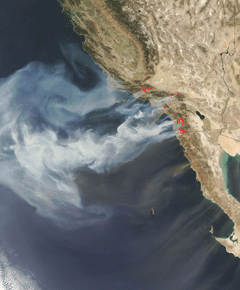
Passing over Southern California at 3:10 p.m. on October 24, 2007, NASA's Terra satellite captured this image of the wildfires that have devastated the area. Red pixels indicate fire activity. These startling images show smoke billowing from the Southern California region out over the Pacific Ocean. (Courtesy of NASA)
[THEME]
CURWOOD: From the Jennifer and Ted Stanley Studios in Somerville, Massachusetts, this is Living on Earth. I’m Steve Curwood.
GELLERMAN: And I’m Bruce Gellerman. In America’s West, October is typically the cruelest month. It’s when drought, winds, and forests as dry as kindling can conspire to create the perfect conditions for firestorms.
CURWOOD: This October has been particularly cruel in southern California. A dozen firestorms swept down the mountains as gusting Santa Ana winds funneled fires through canyons towards coastal cities and towns. Hundreds of square miles were scorched. Hundreds of thousands of people were forced to flee, and a state of emergency was declared.
MAN: Up here the roof was on fire. The coffee shop. But it was so fast of a wind that it was white fire.
MAN 2: And a friend of ours’ house that was framed with steel melted right down to the cement.
WOMAN: The fire creates its own force. It’s not just the fire and wind, it’s worst than that and it’s like a blowtorch.
MAN 3: I guess you get so dehydrated you start getting headaches then you have trouble breathing and then your nose starts bleeding.
WOMAN 2: I’m interested to see what FEMA does. We’re the rich, we’re the famous—or that’s the perception of Malibu—and we have a famous governor. So it’ll be interesting to see what happens to these fire victims.
CURWOOD: And yet, despite the dangers the California dream still entices. So far this decade, some 450,000 people have moved into previously wild areas in the country, and more than half of them chose Southern California. Robert McLeman, professor of Geography at the University of Ottawa, says people know what to expect when they move to the Golden State—and still, they come.

Passing over Southern California at 3:10 p.m. on October 24, 2007, NASA's Terra satellite captured this image of the wildfires that have devastated the area. Red pixels indicate fire activity. These startling images show smoke billowing from the Southern California region out over the Pacific Ocean. (Courtesy of NASA)
MCLEMAN: And when it’s not dry, when it’s wet, there’s also the danger of mudslides or land slips in those same locations. So there are very good reasons why up until recently people did not choose to live in such areas because they were marginal areas for people to live in. So from a scientific sense, it doesn’t make a whole lot of sense. In a practical sense, after the smoke clears, a lot of people have their personal family worth is tied up in that property. And if we were to tell them after the fires that ‘no, you are not allowed to rebuild in these places,’ we’re essentially telling them that ‘your land is now valueless.’ You know, that’s a difficult thing to tell people and probably given the way things work, you know, it would involve lawsuits and a lot of conflict between landowners and the government.
CURWOOD: What makes sense for policy makers to do in a situation like this?
MCLEMAN: It requires a lot of, quite frankly, bravery from an elected official to tell people who have vested economic interests in these areas to say ‘no, we’re going to put the breaks on development and we’re going to discourage people from living in hazardous areas.’ One of the things that governments can do on all levels—from federal right down to local—is to stop subsidizing future development of these types of properties in hazardous areas. And by subsidies I mean, for example, if somebody living up in the dry hills of California wanted to build a nice mansion up there but they were forced to pay the real cost of fire protection, the real cost of water, the true cost of electricity, those prices would be very prohibitive and would discourage a lot of that type of development. I hope that the policy makers do have such courage because there are some tough decisions to be made. These areas are not going to become more suitable for habitation in the future; they’ll only become less suitable.
CURWOOD: Over the next 30 or 40 years, we’re going to see the population of the U.S. go from about 300 million people to over 400 million people. Where are these people going to go if there are now some areas—some coastal areas, some dry hill areas, some drought-prone areas—that maybe don’t make sense to settle?
MCLEMAN: Well a lot will depend on two factors: market forces and social perceptions of where it’s nice to live. Market forces—how long can the government afford to essentially subsidize people living on the Florida coast and in the hills of California and so on, where the government is going to continue to have to, essentially bail people out when there are natural disasters? If it comes to the point where the government starts to remove those subsidies, then the sheer force of market—that when the household has to you know, decide ‘can we afford to pay these increased bills for insurance, for utilities, for infrastructure and so on?’ it may force people to make changes if they decide where they’re going to live.
The other is social perception. Right now, it’s cool to live in California. The California lifestyle is something that many Americans wish to emulate and that’s reinforced by popular culture. At the moment, it’s not perceived to be cool across much of America to live in Buffalo, New York or Eerie, Pennsylvania or Cleveland, Ohio. Maybe that will change. Maybe the idea of a nice cold winter in the mountains of New Hampshire will appeal to people in the future. But right now, that’s not the sort of dynamic we have. People want to live in the Sun Belt and enjoy that type of lifestyle.
CURWOOD: What might we expect in terms of mass migrations in the United States? Places like Buffalo and Cleveland and Detroit aren’t particular popular right now but boy, they’re right alongside a quarter of the world’s fresh water.
MCLEMAN: You’re right. And having those resources at their disposal will be an attraction in the future. Particularly, quite frankly, in the coming decade as water becomes scarce around cities like Atlanta, many cities in Texas and Oklahoma and so on, where if households do have to start paying exorbitant prices for water, then maybe living in a place like Buffalo and Cleveland, where water is affordable as a resource, then maybe that will attract people. But there still has to be some sort of an economic engine in those cities to attract migrants from elsewhere. And perhaps that will come. Again, the free market will decide that.
CURWOOD: Robert McLeman is a professor of geography at the University of Ottawa. So, has the time come to leave southern California?
WOMAN: No, we’ve never thought of moving because of the fire danger.
WOMAN 2: Wildfire, earthquakes, you know, I made that decision a long time ago when I moved from Philadelphia to California that you know, you’re more likely to get hit by a car.
WOMAN 3: Yeah, I am actually thinking of moving.
MAN: Yeah, the only way I’d every move is if all these pretty girls moved.
GELLERMAN: Californians have come to expect wildfires, but scientists say the fires have changed. They’re more intense, they last longer and they’re more destructive. They call them megafires. Between 1986 and 2004 there were four times as many major fires as there were in the 16 years before that. Dr. Kevin Trenberth, head of the Climate Analysis Section at the National Center for Atmospheric Research, says this isn’t due to just cyclical variation in the weather: it’s climate change.
TRENBERTH: One of the interesting things is about how climate change has actually occurred across North America and it’s quite different than many other places all around the world. In general, with global warming, there has been an increase in temperature but the main increases in temperature have occurred in the landmasses. The exception is the region east of the Rockies. And what has happened in that region—because of changes in atmospheric circulation—is that it’s become a lot wetter and it’s also become cloudier. And so the warming has not been as great. But there has been climate change. What has actually happened this year is a reversal of that pattern, a relaxation if you like, of this wetter and cloudier pattern. And so we’ve developed this drought in the southeast and in some ways, the eastern parts of the United States are more vulnerable for a much larger climate change as we move into the future of exactly this nature because the warming that has occurred in that region is much less than we expect based on the climate models.
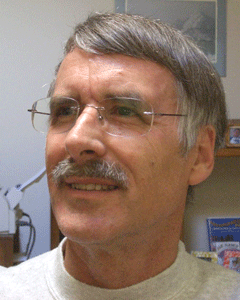
Dr. Kevin E. Trenberth is Head of the Climate Analysis Section at the National Center for Atmospheric Research. (Courtesy of The National Center for Atmospheric Research)
TRENBERTH: Well what we can do is play God in some sense. We can run our climate models and with the changes in composition of the atmosphere—the increases in carbon dioxide—and we can run it without those and we can see what the difference is. And what we find with our climate models is that—in terms of the global mean temperatures—that there’s a separation somewhere around in the 1970s. And so the human influence on climate has emerged if you like from the noise of natural variability since about 1970 and it’s sort of growing in time and then we can also look at patterns of change. In general there has been an overall shift in where storms are occurring in both hemispheres. They’re tending to move a little bit more polewards, a little bit more summer-like regime if you like or summer’s becoming a little longer. Something like that. And it has big impacts on—especially precipitation, changing rain to snow and changing where the rain actually is occurring.
GELLERMAN: But how does that produce a drought in the Southeast and wildfires out West?
TRENBERTH: The warming itself means that there’s extra drying in places where there’s moisture available. That’s the first thing that happens, you know, if there’s been a shower and the sun comes out and the ground is wet, the first thing that happens is all the puddles dry up and then the temperature goes up. And so there’s a petitioning of this extra heat that’s available. Some of it goes into raising temperature and some of it goes into drying, increasing the evaporation. So in places where there is a pattern of the weather which might be set up by something else such as El Nino, if there is a tendency for a natural drought, the drought tends to set in quicker. It becomes more intense and the consequences are greater because of the wilting of plants and it produces a situation ripe for wildfires. And in other places, where the moisture is being transported and getting caught up in storms, you can actually end up having increases in floods.
GELLERMAN: Well you mention El Nino. Could this be El Nino and not something to do with climate change?
TRENBERTH: Well El Nino helps to change the patterns of weather around the world and determines where the droughts tend to occur. In this case we’ve got the opposite of El Nino. It’s actually called La Nina, which refers to cooler than normal sea surface temperatures in the Eastern Tropical Pacific, and that changes the wave patterns around the world. It changes the jet stream and where the storms track overall and across North America, it generally tends to push the jet stream and the storm tracks a little farther to the north and so it favors drier and warmer conditions in the south and that can occur all the way from California through to Florida.
GELLERMAN: So your long-term forecast for the far West and the southeast of the United States—are we seeing the specter of things to come?
TREMBERTH: Yes, I think we are. This is an exaggeration if you like, of things that do occur naturally and that’s really the way to think about how climate change has an impact on things. We can see this in other major events that have occurred around the world and one of the most spectacular ones was the drought and the subsequent heat waves in Europe in 2003, which led to over 30,000 deaths, where the temperatures during the summer were just so far beyond anything that had been seen before that it simply could not have happened by natural variability alone. And if we look and analyze that record and do all kinds of computer experiments with climate models we can indeed identify that yes, there was a contribution of natural variability but there was also a contribution of global climate change from human activities that contributed to that particular event. In other words, it would not have happened without the human influence on climate change.
GELLERMAN: Dr. Trenberth, thank you very much. I appreciate it.
TRENBERTH: You’re most welcome.
GELLERMAN: Climatologist Kevin Trenberth was a lead author of the climate change reports written for the IPCC, the organization which shared this year’s Nobel Peace Prize.
[MUSIC: Chuck Love “Low End” from ‘Bring Enough To Spill Some’ (OM Records—2007)]
CURWOOD: Coming up: Water, water – nowhere. Some southeast states have not a drop to drink. When drought pits neighbor against neighbor. Keep listening to Living on Earth.
The Drought-Stricken South
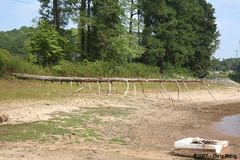
(Photo: (C)2007 Chris Rabig)
STEVE: It’s Living on Earth. I’m Steve Curwood.
GELLERMAN: And I’m Bruce Gellerman. Just ahead: “For What It’s Worth,” Bonnie Raitt steps up to the plate again to speak out against nukes. But first—unlike the raging fires scorching California, the drought in seven southeastern states is a disaster in slow motion. Over the past year and a half sweltering heat and historic low levels of rainfall have wreeked havoc on the region.
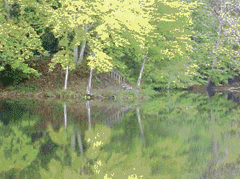
Officials in Monteagle are considering setting up portable water filtration systems on local lakes such as this one to alleviate the drought.(Photo: Monteagle, Tennessee Chamber of Commerce)
ROLLINS: Our reservoir is virtually dried up. We’re holding just a little bit of reserve in case of a major break or a major fire. We are purchasing all the water that we use, about 350,000 gallons a day, from three different utilities. We were put on notice yesterday that the supply may not last but two or three more weeks and it’s put us scrambling to find out what we’re going to do in the near future.
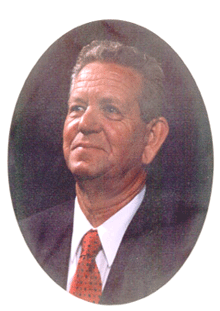
Charles Rollins, Mayor of Monteagle, Tennessee.(Photo: Monteagle, Tennessee Chamber of Commerce)
CURWOOD: The scarcity of precious water has pitted state against state. Lake Lanier in Atlanta is running dry—yet every day the feds release a billion gallons down river, in part to protect threatened shellfish in Florida. Georgia wants to keep its water and is seeking an injunction to suspend the Endangered Species Act. But in Florida, Andrew Smith, who’s the executive director of the Apalachicola Riverkeeper, says jobs are at stake.
SMITH: We produce 13 percent of the nation’s oysters. Those oystermen, out there on the water, are telling us that when they tong up the oysters, 50 percent of them that they’re pulling up are dead. And what you have when you have less freshwater in the bay, you have more saltwater from the Gulf and you have predators like oyster drills and conchs that come and actually predate on the oysters and can decimate an oyster bed.
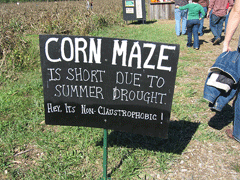
There's nothing corny about this sign at a corn field in Tennessee. (Courtesy of Flickr/ library_chic)
SMITH: What we’re actually seeing is a transition from a pure floodplain wetland system to more of an upland system. The actual plant species are changing. And with less water in the flood plain, which is a wonderful habitat for fish to spawn, we’re having, you know, less opportunities for those species—those fish and other species—to go in there and spawn. So we’re seeing decreased crawfish populations and things like that.
CURWOOD: Now I understand there are some endangered water species there in the Apalachicola. How is the water flow affecting them?
SMITH: There are two endangered mussel species of concern and that’s the purple bankclimber and the three-fat ridge mussel. Those are dependent on there being enough water in the floodplain as well and preliminary reports that we are getting back from scientists looking at the populations there is that there’s a significant amount of mortality in those mussel populations this year due to the decreased flows.
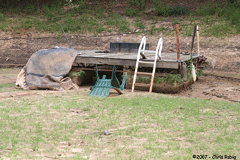
No diving any time soon off of this swim platform in Lake Lanier. (Photo: (C)2007 Chris Rabig)
SMITH: Steve, I don’t think it’s necessary at all. In fact, I think it’s really bad policy. We feel like Georgia is just trying to change federal law when it doesn’t suit them. The mussels didn’t create this crisis. In fact, this crisis wasn’t created by the drought. The crisis came from Atlanta’s failure to conserve water, and its failure to control growth. That’s what’s creating the crisis.

Lake Lanier, Metropolitan Atlanta's main source of water, is drying up. This tree on the lake shoreline is normally underwater. (Photo: (C)2007 Chris Rabig)
CURWOOD: Andy Smith is the executive director of the Apalachicola Riverkeeper. Thanks so much, Andy.
ANDY: You’re welcome, Steve. I’m happy to be able to talk to you.
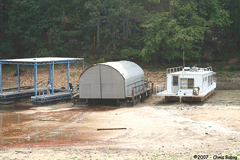
These boats usually float in ten feet of water in Lake Lanier. (Photo: (C)2007 Chris Rabig)
NGUYEN: We do actually have people turning in their neighbors. We’re typically getting about 250 to 400 calls a day. Last week we did have to call the police in twice. We had two separate incidents where the customers were on site and refused to terminate irrigation and actually made physical threats to our staff.
GELLERMAN: One of the largest users of water in Georgia is the state university at Athens, where officials wants to cut consumption by a quarter. Todd Rasmussen, professor of hydrology and water resources at UGA, says there are already changes on campus.
RASMUSSEN: Well, they’ve turned off the outdoor watering systems. The irrigation is off. All the fountains have been drained. The chillers that help air-condition the buildings have been turned down so that there’s less water used in air conditioning, which means the buildings are maybe a little warmer.
GELLERMAN: Now I understand that you’re retrofitting your auto-flush toilets?
RASMUSSEN: The auto-flush toilets have been a problem. They tend to flush with their own sense of mission and they tend to flush too often. We find that the dorms are taping some of the flushing devices closed. There’s somewhat of a competition going on in the dorms to try and save water. They keep track of how much water the students use in dorms and so to get an award they’re trying to reduce as much as possible.
GELLERMAN: I went to your website and you’ve got this fabulous picture of purple pipes. What’s that?
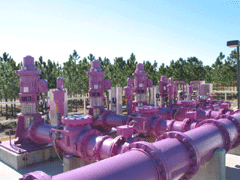
Purple pipes to carry reclaimed water have been installed in many of the city of Clermont's newer subdivisions. The purple color warns plumbers that they are not drinking water. (Courtesy of the City of Clermont, FL)
GELLERMAN: Do you think there could be a silver lining in this cloud—that is, you know, once the drought is over you’ll be conserving more water?
RASMUSSEN: Absolutely. I think these are long-term habits we’re trying to promote. The other thing we’re trying to point out is that when you save water, you’re saving electricity. One of the major uses of water on campus is air conditioning and so, by setting the thermostat a little warmer you’re saving a lot of water and you’re also saving a lot of electricity and so we all need to conserve these days. So there’s so many different benefits we’re effecting by this.
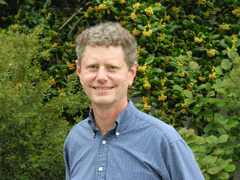
Todd Rasmussen is Professor of Hydrology and Water Resources at the Warnell School of Forestry and Natural Resources of the University of Georgia, Athens.
RASMUSSEN: Well I was in the Peace Corps in Honduras and so we only had water a few hours every day and so you begin to sort of, count the water. So this ‘every drop counts’ is to focus people on ‘how much water do you actually use in a day?’ And when you’re filling buckets from the sink you get a certain sense about how much water you’re wasting. And that’s the one comment I’ve heard from a lot of people was that they didn’t realize just how much water they were using and I think we could dramatically decrease the amount and our impact, our hydrologic footprint so to speak on our community, by just trying to be aware of where you use water, how you use it, and how you might do better in conserving this resource.
GELLERMAN: Todd Rasmussen is professor of hydrology and water resources at the University of Georgia Athens. Professor, thank you very much.
CURWOOD: Well, thank you Bruce.
Related links:
- Monteagle, Tennessee Homepage
- Cobb County, Georgia Homepage
- The University of Georgia Athens "Every Drop Counts"
- Apalachicola RiverKeeper
- Kevin Trenberth Hompage
[MUSIC: Zack Brock “Almost Never Was” from ‘Live At The Jazz Factory’ (Secret Fort Records—2007)]
On the Road
CURWOOD: Commentator Verlyn Klinkenborg recently spent some time in Southern California and then drove back home to his farm in rural New York. Along the way, he found himself pondering the meaning of ‘home.’
KLINKENBORG: Whenever I drive across country, I carry a single question with me. Could I live here? It's a central question for a species whose habitat is defined as much by imagination and emotion as it is by biological constraints. And it's a question that raises the matter of time as much as place.
Cutting across central Wyoming, I see a sheltered spot under the hills where the sagebrush breaks into grass, and I think, 'I could live there.’ And I could, now, because living anywhere has been made so easy in our time. It's no longer really a problem of physical limits—how far you have to haul water and salt and flour, how long you can go without company. But what I'm really asking when I wonder ‘could I live here?’ is ‘who would I be if I did live here?’ To that question I never know the answer.
I see an abandoned farmhouse on the high plains, the ruins of a few old cottonwoods, and I can imagine hearing the notes of a meadowlark being carried away on the wind as I go to work on the place. I have to remind myself that in this simple experiment in relativity, I cannot allow myself to imagine living anywhere I can see from my current position. But what if it were a place just like this and over the horizon, out of the sight of so much movement?
Perhaps this is a mental game everyone plays—a way to test the life you are actually living. You drive through a small town at night and wonder what it would be like to feel at home in one of those houses where only the bedroom lamp is still shining. You wonder what your own life would look like if you could somehow stand outside it as a stranger.
But what this question always confirms in me is something I must have understood when my wife and I decided to settle on a small farm in the country. Driving across America, I see place after place I can happily imagine living. And what I notice is that they are mostly uninhabited places.
So Nebraska comes to an end, and the next day we drive into Iowa, where I have already lived a good part of my life. It’s been raining since dawn, and now the wind is pounding down from the north. The rain has begun to cut across the hillside fields and run down to the creeks and rivers, carrying Iowa away to the Gulf of Mexico. Two more days on the road and we will be back in the place where I no longer wonder if I could live there because this is the place it turns out I live.
CURWOOD: Verlyn Klinkenborg is an editorial writer for the New York Times.
[MUSIC: Bonnie Raitt “Home” from ‘Sweet Forgiveness’ (Warner Bros—1977)]
Rockin' For a Nuke-Free World
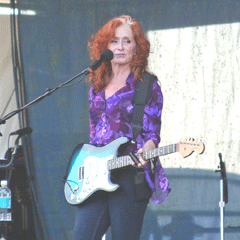
Bonnie Raitt is a nine-time Grammy winner. (Courtesy of Flickr/Mattmc89)
GELLERMAN: Singer-songwriter Bonnie Raitt has been playing her distinctive blend of bluesy-rock and soulful lyrics since the 1960s. She’s recorded 18 albums and won nine Grammys.
CURWOOD: Raitt is not only a musical institution. She’s also a social activist. In 1979 she played Madison Square Garden with Graham Nash and Jackson Browne at an anti-nuke concert soon after the Three Mile Island meltdown.
[MUSIC: “Runaway” from 1979 No Nukes Concert at Madison Square Garden (YouTube)]
GELLERMAN: Now, nearly three decades later, Bonnie Raitt, Browne, and Nash are at it again, joining forces and voices against nuclear power. They have a new video on YouTube called “Stop the Nuclear Bail Out,” adding new lyrics to the song “For What It’s Worth.”
Bonnie Raitt says it’s a protest against a single sentence in the new energy bill that would provide tens of billions of dollars in federal loan guarantees to the nuclear industry, which hopes to build new power plants.
RAITT: Yeah, this is an industry that has not been able to get insurance. And it’s been subsidized by the American people all this time. And basically the way that this is written—we’re trying to get this amendment out of the current, otherwise-great energy bill, which has wonderful renewable standards and all kinds of things that a coalition within the government have worked really hard to put forth. This language deserves to come out because it basically is a blank check to the nuclear industry that will then go to Wall Street and get investment and be off and running building new plants and, for which we have no solution to the storage and the safety and the transport. On every level, it’s going to be just not worth it to go to the nuclear option.

Bonnie Raitt is a nine-time Grammy winner.
(Courtesy of Flickr/Mattmc89)
RAITT: Well I’ve been doing that in my concerts and especially in rallies and political—I think it’s a wonderful song by the Buffalo Springfield. I’ve been singing it since my teen years and Jackson suggested it and we have Ben Harper and Keb Mo and Graham Nash on the video and it’s just a song that was easily recognizable and we could amend the lyrics and use it as a base on our YouTube video that’s out now and let people know about this information about safe energy and nuclear power.
[YOUTUBE VIDEO]
GELLERMAN: There’s a rebuttal to your video on YouTube. It’s with Elizabeth King, who’s with the Nuclear Energy Institute. I want you to listen to a little clip that I took out of that:
KING: Today’s reality is that nuclear energy supplies more than 70 percent of our electricity production that does not emit greenhouse gases. To fight global warming, and meet our electricity needs, we need to invest in all kinds of power plants, including nuclear and renewables. So, for what it’s worth, I support clean and safe nuclear energy for me, and for future generations. Maybe you should, too.
GELLERMAN: Well she’s saying that you know, nuclear power is a non-greenhouse-gas producing form of electricity.
RAITT: Do you want to trade poisonous, radioactive emissions and waste in exchange for what they say is a lower CO2 emission? I mean it’s just, the cost and the expense and the risk and the problems of nuclear power have not been solved and in our opinion, it’s not clean energy. And I just don’t agree with her premise.
GELLERMAN: And you think music as a form of protest still works today? And does it work in the medium of online today? I mean you can sit there with your laptop listening to and watching your video. It’s different than you know taking to the ramparts and protesting and getting arrested on the streets.
RAITT: Well I think the great news about the Internet is that you can see democracy at work. I mean it started with Governor Dean’s campaign and MoveOn and groups like that where we started to be able to educate people and circulate petitions and get people to call their congresspeople and be—participate in the democratic process again on almost every level, on the right and the left. It’s a revolution that’s changed the political landscape for activism.
In terms of music, you know—we know that people love to hear our music. Hopefully they love to hear our music, but the reason we speak out is because we’re citizens. You know, we’re musicians second and citizens first. And we may use our music to be able to garner attention and get the microphone so that people will listen to the side of the argument that maybe isn’t being funded by the huge corporations that are able to buy op-eds in the newspapers and put people into congressional seats. We’re standing up for the folks that don’t have that kind of big money.
GELLERMAN: Am I going to sound like an old fogie if I say goodbye to you and say ‘rock on,’ Ms. Raitt?
RAITT: Oh no! Are you kidding? I’m rocking on, you know. I’m hoping I’ll be rocking on when I’m 80 and let’s hope I don’t have to be talking about nuclear power then.
GELLERMAN: Well Ms. Raitt, thank you very much.
RAITT: Thank you very much, Bruce. Living on Earth!
Related links:
- To See the video:
- Bonnie Raitt's website
- Bonnie Raitt protesting nuclear in 1979 in Madison Square Garden
- The Department of Energy's ruling
- A response from the Nuclear Energy Institute on youtube
GELLERMAN: You can hear our program anytime on our website or get a download for your mp3 player. The address is loe.org. That’s L-O-E-dot-O-R-G. You can reach us at comments at l-o-e dot org. Once again. comments at L-O-E-dot-O-R-G. Our postal address is 20 Holland Street, Somerville, Massachusetts, 02144. And you can call our listener line at 800-218-998. That’s 800-218-99-88.
[MUSIC: Rolling Stones “Casino Boogie” from ‘Exile On Main Street’ (ABKCO Music—1972)]
CURWOOD: Just ahead—let’s go fly a kite. It could be the next big thing in renewable energy. Stay tuned to Living on Earth.
ANNOUNCER: Support for the environmental health desk at Living on Earth comes from the Cedar Tree Foundation. Support also comes from the Richard and Rhoda Goldman Fund for coverage of population and the environment. This is Living on Earth on PRI: Public Radio International.
Climate in the Congress
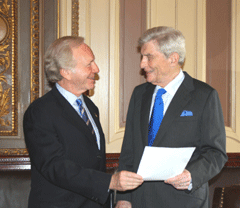
Senators Lieberman and Warner reviewing the America's Climate Security Act. (Courtesy of the U.S. House of Representatives)
CURWOOD: It’s Living on Earth. I’m Steve Curwood.
GELLERMAN: And I’m Bruce Gellerman. The U.S. Senate has started work on what may be the best chance Congress has to cap the country’s greenhouse gas emissions. The bipartisan bill on global warming has momentum thanks to unexpected support from a senior Republican Senator: John Warner of Virginia.
CURWOOD: But his bill is taking heat from both sides: environmental activists say it doesn’t do enough to cut carbon in the atmosphere; industry argues it would push energy costs sky high. Living on Earth’s Jeff Young tells us about the climate change tug of war and the man in the middle.
YOUNG: Republican John Warner seems an unlikely champion of action on climate change. His home state of Virginia mines and burns a lot of coal. And Warner is often at odds with environmental groups when he votes for oil drilling offshore and in the Arctic Refuge. So why has the 80-year-old senator made global warming the top priority for his last year before retirement?
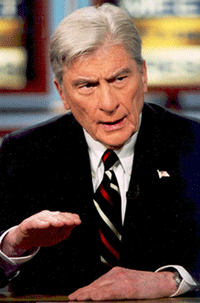
Sometimes called the "Senator from Central Casting," the dashing John Warner (R-VA) was once married to Liz Taylor. (Courtesy of the U.S. House of Representatives)
YOUNG: The ex-marine and former Navy secretary also sees a strong link between climate change and his first passion: national security. He’s partnered with Connecticut Independent Senator Joe Lieberman on a bill they call ‘America’s Climate Security Act.’ It’s similar to a bill Lieberman sponsored with Senator John McCain four years ago. But this one already has more support. In fact, Lieberman says, four of his cosponsors on this bill voted against the earlier one.
LIEBERMAN: So this thing is moving. And I think it’s moving in the right direction because we have answered in this bill some of the questions and concerns about the economic consequences.
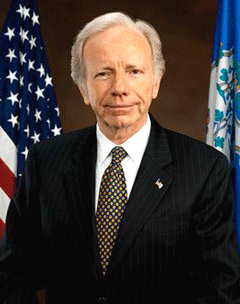
Senator Joe Lierberman (D-CT) (Courtesy of the U.S. House of Representatives)
LIEBERMAN: We create a steady glide path down and that’s going to be easier for the sources of emissions to deal with.
YOUNG: The Lieberman-Warner plan gives away some emissions credits in the early years. Roughly half would be free at first; the rest auctioned off. The bill also sets up an independent board with the power to provide more emissions credits if energy prices spark sharply. But Missouri Republican Kitt Bond doesn’t think that’s enough.
BOND: Families will face pain at the pump, higher home electricity and gas bills. Workers in energy-intensive sectors will face layoffs with their jobs going overseas to countries with lower energy costs. Hardest hit will be the weak and vulnerable with no extra room in their budget for higher energy costs. The poor, the fixed income will suffer.

Senators Lieberman and Warner reviewing the America's Climate Security Act. (Courtesy of the U.S. House of Representatives)
O’DONNELL: Those permits or those allowances have an economic value. They are like giving them cash. It’s a giveaway that could potentially run into the billions, if not trillions of dollars of economic value to the worst polluters—the ones that actually got us into this global warming mess in the first place.
YOUNG: O’Donnell says this would repeat early mistakes made by the European Union when it set up a carbon-trading system that gave polluting companies billions in windfall profits without achieving the goals of emissions reductions. Environmentalists also say Senators Warner and Lieberman would not reduce greenhouse gases enough to avoid dangerous warming. The bill shoots for reductions somewhere between 50 and 60 percent by mid century. Vermont Independent Senator Bernie Sanders says that might be good politics, but not good policy.
SANDERS: You can have all the bargaining you want, you can have all the nonpartisanship you want, and yet this planet will face catastrophic damage unless we deal with the reality of the science.
YOUNG: Sanders cites recommendations from leaders of the Intergovernmental Panel on Climate Change, which recently shared the Nobel Peace Prize. They call for 80 percent reductions by the year 2050. Warner knew right away that his newfound interest in climate will make his last year in the Senate a stormy one.
WARNER: We have formulated a starting point for the Congress to assume its leadership. We’re off. We’re out of the starting gate.
YOUNG: For Living on Earth, I’m Jeff Young in Washington.
Related link:
Senator Lieberman's press release on the Climate Security Act
GELLERMAN: Coming up, Colorado embraces wind power. But first, this Cool Fix for a Hot Planet from Alexandra Gutierrez.
[MUSIC: The Free Design "Kites Are Fun (Mellow Mix)" from 'The Now Sound Redesigned' (Light In The Attic – 2005)]
CoolFix for a Hot Planet
GUTIERREZ: Think renewable energy, and kite surfing probably doesn't come to mind. Unless, of course, you’re Allister Furey.
Furey is a robot scientist at the University of Sussex in England, who spends his weekends kite surfing. Now, he’s combining work and play to make wind energy production more efficient.
[THEME]
Wind energy has long been lauded as one of the cleanest forms of energy available, but it accounts for less than two percent of all energy produced. That’s because it isn’t practical in places that aren’t particularly breezy.
While flying kites, Furey noticed higher altitude winds tended to be much faster than the winds near the ground. If high-flying kites could harness these strong winds, energy would be available nearly everywhere.
Furey began collaborating with the KiteGen project. Their goal is to create a system that produces energy through kites attached to turbines. KiteGen’s biggest challenge is finding a way to keep the kites in the air while maximizing the amount of power produced. The scientists use a process called ‘neural networking’ where the kites are controlled by computers and fly without human input.
The first batch of these freethinking kites crashed within a split second. But the KiteGen scientists kept the traits of the smartest kites, allowing them to fly longer. KiteGen hopes to make this technology commercially available. For now though, some of these super kites are already soaring through the sky, extracting energy previously inaccessible to normal wind turbines. That’s this week’s Cool Fix for a Hot Planet. I’m Alexandra Gutierrez.
CURWOOD: If you or someone you know has a Cool Fix for a Hot Planet, please let us know. And if we use your idea on the air, you’ll get a Living on Earth tire gauge. Call our listener line at 800-218-9988, that's 800-218-99-88. Or email coolfix—that’s all one word—at loe.org. That's coolfix at l-o-e dot org.
Headway on Clean Electricity
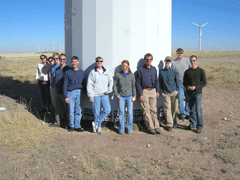
The scale of a modern wind turbine is shown by students from CU Boulder. (Photo: Paul Komor/ Courtesy University of Colorado-Boulder, Environmental Studies)
GELLERMAN: Kite-generated power may be just a pie in the sky today, but it is a reminder that a lot of folks are looking at ways to stop doing things that aggravate global warming. A prime target of concern is the electric power industry. More than two thirds of electric power in the United States comes from the burning of fossil fuel. And that means power plants put more global warming gases into the air than all of America’s cars, trucks, planes and ships combined.
CURWOOD: In the face of federal inaction, states have been taking the lead in curbing these emissions, including Colorado, where voters passed a measure in 2004 requiring electric utilities to get at least ten percent of their power from renewables. This year, the state went even further.
And with me now to talk about Colorado’s progress on clean energy is the chief of the Governor’s Energy Office, Tom Plant. Welcome Tom.
PLANT: Thank you, Steve. It’s good to be here.
CURWOOD: So tell me, by the end of this year Colorado will be getting how much of its energy cleanly?
PLANT: Well our major utility, Xcel Energy, is going to be getting about ten percent of its total electricity from renewable resources by the end of this year. And that’s the interesting and amazing thing about that is that it’s eight years before the mandated standard that was set up in amendment 37. They said that Xcel needed to get ten percent by 2015 and here we are eight years early and we’re going to be meeting that standard.
CURWOOD: Now, California recently passed legislation prohibiting the purchase in long-term contracts of any dirty electricity. I’m wondering how much this fits into plans in Colorado to build more wind farms.
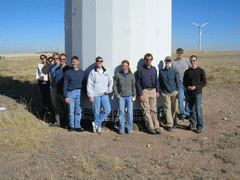
The scale of a modern wind turbine is shown by students from the CU Boulder Environmental Studies Program. (Photo: Paul Komor/ Courtesy of University of Colorado-Boulder, Environmental Studies)
CURWOOD: You’re not worried about California? First they want your water, now they want your wind?
PLANT: (laughs) Well, wind is one of those things where we have a lot of resource. We don’t have as much demand as we do have resource so we’re more than willing to put it on the wires and get it out to where that demand is.
CURWOOD: So how much untapped wind energy does Colorado still have at this point?
PLANT: Boy, you know, it’s a fantastic question. You know, who knows? We are continuing to see increases in the efficiencies of the turbines. You know, what we thought was maybe one megawatt a few years ago is now producing three megawatts. So, what that production will be in the future we don’t know. But we do know that we have a fantastic resource and we do know that that resource is very widespread throughout the West.
CURWOOD: So, Tom, what advice would you give to advocates and decision makers in other states about how to move the agenda of renewable energy forward?
PLANT: Well, you know, I’d say ‘take Colorado as an example and gain experience from our experience.’ Just a couple of years ago, after four years of failed legislative attempts, the people of Colorado put amendment 37 on the ballot. It established a ten percent renewable electricity standard by 2015, and here we are just a couple of years later, the same utilities—every utility in the state opposed it—and the same utilities that opposed it now went back to the legislature and said ‘we support doubling that standard.’ And it was because many of their assumptions were wrong.
CURWOOD: What were the biggest fears of the energy industry that have now not come to pass?
PLANT: Well, one was that it was going to increase costs for the consumer. In fact, it hasn’t increased costs. The second thing was that it wasn’t going to be producing enough to be able to contribute to the grid—intermittent power wasn’t reliable enough.
CURWOOD: Well, wait a second. The wind only blows some of the time. It’s intermittent energy. Why isn’t that a problem?
PLANT: Well, it’s true that it only blows some of the time but one of the really interesting things that we’re also finding as we study wind development patterns around the West is that there’s not a consistent time when all wind is being produced. For example, if you look at the wind production patterns in southeastern Wyoming, they complement the wind production patterns in southeastern Colorado. So you end up with these offsetting production times which creates a much more stable source of power. I think that’s one of the real challenges for the country as we go forward is broadening this network of transmissions so that we can take advantage of the different times that renewable resources are producing in different areas of the country at different times of the day.
CURWOOD: Well thanks for taking this time with me Tom. Tom Plant is the director of the Energy Office for Colorado Governor Bill Ritter. Thank you so much, Tom.
PLANT: Thank you, Steve.
CURWOOD: Now, Colorado isn’t the only state where renewable energy is beginning to register. New Mexico doubled its clean energy requirement at the same time as Colorado and other states are charging ahead. With me now to provide a national picture is Alan Nogee. He’s director of the Union of Concerned Scientists’ energy division. Thanks for coming in, Alan.
NOGEE: Thanks for having me.
CURWOOD: So I guess if we look at which states have made the most progress, it depends on the number you choose. Let’s start with the goals. Which states are aiming to get the highest percentage of their electricity from clean resources?
NOGEE: Well we now have 25 states plus the District of Columbia that have renewable electricity standards and about a dozen of them are above 20 percent in terms of their requirement. Among the leaders are Minnesota, at 27 percent; California is now 20 percent in law but is considering going to 33 percent and has a state goal of 33 percent; New York’s at 24 percent; and New Jersey and Connecticut up over 20. A growing number of states are looking at meeting or beating 20 percent renewable electricity by the year 2020.
CURWOOD: And then let’s look at the states that are getting already right now to the ten percent level. Who might be ahead of Colorado?
NOGEE: Well Maine is really the national leader because back in the 1970s and early 80’s, they really began developing both their small hydro and their bio energy—their waste wood resources. So Maine is actually about 30 percent today and looking to go higher. After that, you’ve got a number of states that are just into the double digits, including California, New York, and you’ve got a number of states that are meeting or beating their recently enacted renewable electricity standards. There are about a half a dozen states that are on or ahead of schedule in meeting their standards.
CURWOOD: Now, statistics can be played a number of different ways. Let’s look at the absolute amount of power that’s being generated in a clean fashion and in that case, the winner would be?
NOGEE: California has been the leader but in fact, recently, specifically with respect to wind energy, Texas took the lead, as a result of the renewable standard that it enacted in 1999, actually signed by then Governor George W. Bush. Texas has had a huge boom in wind development in the last seven years so we’re there now in the lead from California.
CURWOOD: How many megawatts are we talking about in Texas?
NOGEE: You’ve got about 4,000 megawatts now, I believe. And looking to get to 6,000 and considering raising the standard to 10,000 or 20,000 megawatts.
CURWOOD: So 4,000 of electricity. Is that enough to run San Antonio?
NOGEE: Well I’m not sure off hand how big San Antonio is. One megawatt, a typical small megawatt wind turbine could supply about 250 homes. Nationally, if you look at all of the renewable standards in place, if they achieve their objectives, we could be powering 20 million homes by the year 2020.
CURWOOD: And all this expansion that we’ve been talking about today, this is all essentially wind and--?
NOGEE: It’s primarily wind although also some bio-energy use, landfill gas, there’s new geothermal development happening now in California and the Southwest where you tap the heat deep inside the earth to generate electricity.
CURWOOD: So, your organization, Alan, the Union of Concerned Scientists, tracks the states’ progress on clean energy pretty closely. So as you look at a map of the country—what stands out most for you?
NOGEE: Well what I think what stands out most is there’s still a few regions that really haven’t made much progress, primarily in the Southeast, the Rust Belt, industrial Midwest, and some of the plains and mountain states. We’re starting to fill in the pieces of the map but what we really need is a national standard that sets a minimum requirement for all utilities in the country. And such a standard did pass the House of Representatives over the summer and is up for discussion as the House and the Senate try to reconcile their energy bills.
CURWOOD: Alan, thanks so much for coming into the studio today. Alan Nogee heads up the energy program at the Union of Concerned Scientists in Cambridge, Massachusetts.
NOGEE: Thank you, Steve.
Related links:
- Union of Concerned Scientists: State Clean Energy Maps and Graphs
- Clean Power.org
- Renewable Access Energy
- State of Colorado: Governor's Energy Office
- Wind Project Database with state by state comparisons
[MUSIC: Carlos Santana/Wayne Shorter “For Those Who Chant” from ‘Spiritual Live At The Montreaux Jazz Festival 1988’]
GELLERMAN: Next week on Living on Earth, scientist and environmental activist Vandana Shiva has made it her mission to speak out against industrial food farms and chemical agriculture.
SHIVA: The entire food system is today serving corporations and not serving people or the planet. We need to reclaim the food system.
GELLERMAN: The food and seed revolution of Vandana Shiva, on the next Living on Earth.
CURWOOD: Living on Earth is produced by the World Media Foundation and our crew includes Ashley Ahearn, Eileen Bolinsky, Ingrid Lobet, Helen Palmer, Emily Taylor, and Jeff Young, with help from Bobby Bascomb and Kelley Cronin. Our interns are Alexandra Gutierrez and Mitra Taj.
GELLERMAN: Jeff Turton is our technical director. Alison Lirish Dean composed our themes.
CURWOOD: You can find us anytime at loe.org. I’m Steve Curwood.
GELLERMAN: And I’m Bruce Gellerman. Thanks for listening.
ANNOUNCER: Funding for Living on Earth comes from the National Science Foundation, supporting coverage of emerging science. And Stonyfield Farm: organic yogurt and smoothies. Stonyfield pays its farmers not to use artificial growth hormones on their cows. Details at Stonyfield.com. Support also comes from you our listeners, the Ford Foundation, the Town Creek Foundation, the Oak Foundation, supporting coverage of climate change and marine issues, and Pax World Mutual Funds, socially and environmentally sustainable investing. Pax World: for tomorrow. On the Web at PaxWorld.com.
ANNOUNCER 2: PRI: Public Radio International.
Living on Earth wants to hear from you!
Living on Earth
62 Calef Highway, Suite 212
Lee, NH 03861
Telephone: 617-287-4121
E-mail: comments@loe.org
Newsletter [Click here]
Donate to Living on Earth!
Living on Earth is an independent media program and relies entirely on contributions from listeners and institutions supporting public service. Please donate now to preserve an independent environmental voice.
NewsletterLiving on Earth offers a weekly delivery of the show's rundown to your mailbox. Sign up for our newsletter today!
 Sailors For The Sea: Be the change you want to sea.
Sailors For The Sea: Be the change you want to sea.
 The Grantham Foundation for the Protection of the Environment: Committed to protecting and improving the health of the global environment.
The Grantham Foundation for the Protection of the Environment: Committed to protecting and improving the health of the global environment.
 Contribute to Living on Earth and receive, as our gift to you, an archival print of one of Mark Seth Lender's extraordinary wildlife photographs. Follow the link to see Mark's current collection of photographs.
Contribute to Living on Earth and receive, as our gift to you, an archival print of one of Mark Seth Lender's extraordinary wildlife photographs. Follow the link to see Mark's current collection of photographs.
 Buy a signed copy of Mark Seth Lender's book Smeagull the Seagull & support Living on Earth
Buy a signed copy of Mark Seth Lender's book Smeagull the Seagull & support Living on Earth

